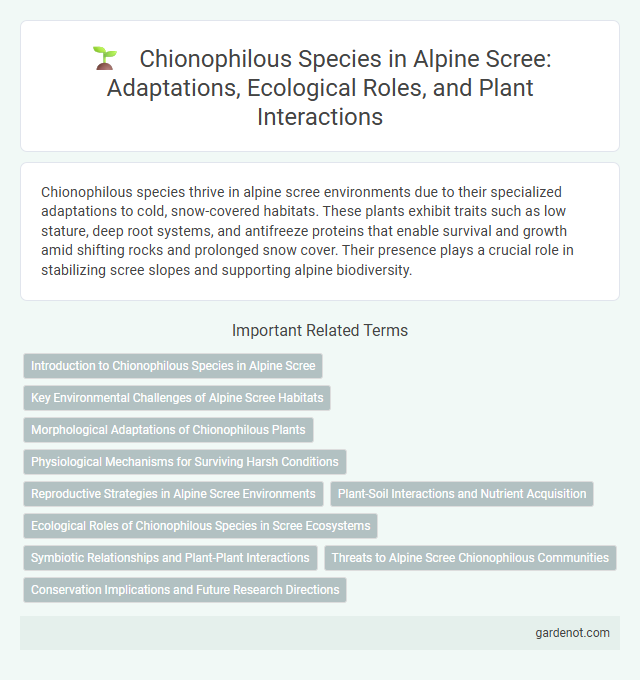Chionophilous species thrive in alpine scree environments due to their specialized adaptations to cold, snow-covered habitats. These plants exhibit traits such as low stature, deep root systems, and antifreeze proteins that enable survival and growth amid shifting rocks and prolonged snow cover. Their presence plays a crucial role in stabilizing scree slopes and supporting alpine biodiversity.
Introduction to Chionophilous Species in Alpine Scree
Chionophilous species are plants adapted to thrive in the harsh conditions of alpine scree, where snow cover persists for extended periods, influencing soil moisture and temperature. These species possess specialized traits such as cold tolerance, shallow root systems, and slow growth rates, enabling survival in nutrient-poor, rocky substrates with frequent freeze-thaw cycles. Their ecological role is crucial in stabilizing scree slopes and supporting alpine biodiversity by providing habitat and food resources for specialized fauna.
Key Environmental Challenges of Alpine Scree Habitats
Chionophilous species in alpine scree habitats face critical environmental challenges such as extreme temperature fluctuations, limited soil development, and short growing seasons that restrict nutrient availability. These species must adapt to frequent freeze-thaw cycles and unstable substrate conditions, which hamper root establishment and water retention. Climate change accelerates snowmelt timing, further disrupting microhabitats and threatening the survival of cold-adapted flora specialized for these high-elevation scree environments.
Morphological Adaptations of Chionophilous Plants
Chionophilous plants exhibit specialized morphological adaptations such as reduced leaf size and thick cuticles to minimize water loss in the harsh alpine scree environment. Their compact, cushion-like growth forms protect against cold temperatures and mechanical damage from shifting rocks and snow. Deep root systems anchor these plants securely in unstable scree substrates, enhancing nutrient uptake and stability.
Physiological Mechanisms for Surviving Harsh Conditions
Chionophilous species in alpine scree employ specialized physiological mechanisms such as antifreeze protein production and osmoprotectant accumulation to prevent cellular damage during freezing temperatures. These adaptations enhance membrane stability and maintain metabolic function despite recurrent freeze-thaw cycles. Additionally, efficient water retention strategies and delayed phenology allow these plants to optimize resource use in nutrient-poor, unstable scree environments.
Reproductive Strategies in Alpine Scree Environments
Chionophilous species in alpine scree environments employ reproductive strategies adapted to harsh, cold conditions with unstable substrates, such as producing numerous lightweight seeds that facilitate wind dispersal and rapid germination during short growing seasons. These plants often exhibit clonal reproduction through rhizomes or stolons, enhancing their ability to colonize sparse scree habitats and maintain genetic stability despite environmental stress. Synchronizing flowering and seed set with brief summer bursts maximizes reproductive success and ensures species persistence in dynamic alpine scree ecosystems.
Plant-Soil Interactions and Nutrient Acquisition
Chionophilous species thriving in alpine scree develop specialized root systems that enhance nutrient uptake in nutrient-poor, cold soils by forming symbiotic associations with mycorrhizal fungi, which facilitate phosphorus and nitrogen acquisition. These plants often alter soil pH and organic matter through root exudates, promoting microbial activity critical for nutrient cycling in harsh alpine environments. Adaptations such as slow root growth and efficient nutrient reutilization optimize survival and growth within the dynamic scree substrate characterized by frequent freeze-thaw cycles and limited soil development.
Ecological Roles of Chionophilous Species in Scree Ecosystems
Chionophilous species in alpine scree ecosystems play crucial roles in nutrient cycling and soil stabilization by thriving in cold, snow-rich conditions. Their adaptations to freezing temperatures support microhabitats that facilitate biodiversity and ecological succession in these harsh environments. These species often act as pioneer organisms, enabling the establishment of other plants and contributing to the overall resilience of the scree habitat.
Symbiotic Relationships and Plant-Plant Interactions
Chionophilous species in alpine scree demonstrate complex symbiotic relationships, such as mycorrhizal associations that enhance nutrient uptake in nutrient-poor, rocky soils. These plants often engage in facilitative plant-plant interactions, where pioneering species improve microhabitat conditions by stabilizing scree substrates, allowing other species to establish. Such mutualistic dynamics promote biodiversity and ecosystem resilience in harsh alpine environments.
Threats to Alpine Scree Chionophilous Communities
Chionophilous species in alpine scree face significant threats from climate change, which alters snow cover duration and stability, disrupting their specialized habitats. Human activities such as hiking and construction increase habitat fragmentation and soil erosion, further endangering these fragile communities. Invasive plant species also compete with native chionophilous flora, reducing biodiversity and resilience in alpine scree ecosystems.
Conservation Implications and Future Research Directions
Chionophilous species in alpine scree environments face heightened vulnerability due to climate change-induced snow cover reduction and habitat fragmentation, necessitating targeted conservation strategies to preserve their specialized ecological niches. Protecting these cold-adapted organisms requires habitat connectivity maintenance and microhabitat stability monitoring to mitigate population declines. Future research should prioritize long-term population dynamics, genetic diversity assessments, and the impacts of shifting snow regimes on species distribution and adaptation potential.
Chionophilous species Infographic

 gardenot.com
gardenot.com